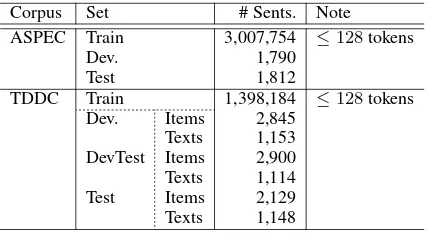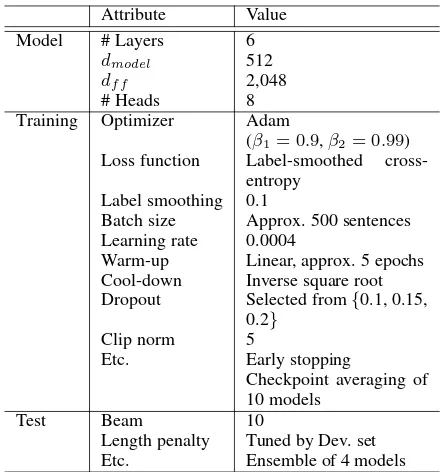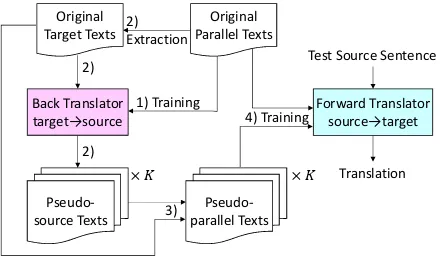Proceedings of the 6th Workshop on Asian Translation, pages 141–146 141
Long Warm-up and Self-Training:
Training Strategies of NICT-2 NMT System at WAT-2019
Kenji Imamura and Eiichiro Sumita
National Institute of Information and Communications Technology 3-5 Hikaridai, Seika-cho, Soraku-gun, Kyoto 619-0289, Japan
{kenji.imamura,eiichiro.sumita}@nict.go.jp
Abstract
This paper describes the NICT-2 neural ma-chine translation system at the 6th Workshop on Asian Translation. This system employs the standard Transformer model but features the following two characteristics. One is the long warm-up strategy, which performs a longer warm-up of the learning rate at the start of the training than conventional ap-proaches. Another is that the system intro-duces self-training approaches based on mul-tiple back-translations generated by sampling. We participated in three tasks—ASPEC.en-ja, ASPEC.ja-en, and TDDC.ja-en—using this system.
1 Introduction
This paper describes the NICT-2 neural machine translation (NMT) system at the 6th Workshop on Asian Translation (WAT-2019) (Nakazawa et al., 2019). This system employs Vaswani et al. (2017)’s Transformer base model but improves translation quality by applying the following train-ing strategies and hyperparameters.
• We investigated the relationship between the learning rate, warm-up, and model perplex-ity, and found that a long warm-up allows high learning rates, and consequently the translation quality improves. According to this finding, we applied the long warm-up.
• We applied the self-training strategy, which uses multiple back-translations generated by sampling (Imamura et al., 2018) to increase the robustness of the encoder and improve the translation quality.
The remainder of this paper is organized as fol-lows. Section 2 summarizes the system, includ-ing its settinclud-ings. We describe the characteristics
Corpus Set # Sents. Note
ASPEC Train 3,007,754 ≤128tokens
Dev. 1,790
Test 1,812
TDDC Train 1,398,184 ≤128tokens
Dev. Items 2,845
Texts 1,153
DevTest Items 2,900
Texts 1,114
Test Items 2,129
[image:1.595.309.524.221.339.2]Texts 1,148
Table 1: Corpus sizes.
of our system—the long warm-up and the self-training based on multiple back-translations by sampling—in Sections3and4, respectively. The results are presented in Section5. Finally, Section 6concludes the paper.
2 System Summary
We participated in three tasks, namely English-to-Japanese and English-to-Japanese-to-English of ASPEC (ab-breviated to ASPEC.en-ja and ASPEC.ja-en, re-spectively), and Japanese-to-English of the TDDC (TDDC.ja-en).
The corpus used in the ASPEC tasks is Asian Scientific Paper Excerpt Corpus (Nakazawa et al., 2016), which is a collection of scientific papers. In the TDDC task, the Timely Disclosure Documents Corpus (TDDC) was used. The development and test sets of TDDC are divided into items and texts sets, which are collections of titles and body texts, respectively. The sizes of the corpora are shown in Table1.
Attribute Value
Model # Layers 6
dmodel 512
df f 2,048
# Heads 8
Training Optimizer Adam
(β1= 0.9,β2= 0.99)
Loss function Label-smoothed cross-entropy
Label smoothing 0.1
Batch size Approx. 500 sentences Learning rate 0.0004
Warm-up Linear, approx. 5 epochs Cool-down Inverse square root Dropout Selected from{0.1, 0.15,
0.2}
Clip norm 5
Etc. Early stopping
Checkpoint averaging of 10 models
Test Beam 10
Length penalty Tuned by Dev. set
[image:2.595.70.291.60.296.2]Etc. Ensemble of 4 models
Table 2: Summary of system settings.
We used fairseq1 as a basic translator. The model used here is the Transformer base model (six layers). Table 2 shows the hyperparameters of the model, training, and test.
Training was performed on Volta 100 GPUs (two GPUs for the ASPEC dataset and one GPU for the TDDC dataset) using 16-bit floating point computation. The training was stopped when the loss of the development set was minimized (i.e., early stopping). We also used checkpoint averag-ing: using the best checkpoint and the next nine checkpoints (10 checkpoints in total).
During testing, we used 32-bit floating point computation. For the final submission, four mod-els, which were trained using different random seeds, were ensembled (Imamura and Sumita, 2017).
3 Long Warm-up
The warm-up is a technique that gradually in-creases the learning rate at the beginning of train-ing. The most general strategy is to increase the learning rate linearly. Using the warm-up, the model parameters are updated toward conver-gence, even if they were randomly initialized. This allows us to obtain stable models.
We generally use a fixed time for the warm-up. For example,Vaswani et al.(2017) used 4,000 up-dates in their experiments. However, the warm-up
1https://github.com/pytorch/fairseq
3K 6K 12K 18K 30K 60K
90K 4.2
4.3 4.4 4.5 4.6
1.e-04 2.e-04
3.e-04 4.e-04
5.e-04
W
a
rm
-u
p
(
#
u
p
d
a
te
s)
D
e
v.
P
P
L
[image:2.595.310.526.62.205.2]Learning Rate
Figure 1: Relationship between learning rate, warm-up, and perplexity of development set in ASPEC.ja-en task.
time influences the final quality of models. Figure 1 shows how the development set per-plexity (Dev. PPL) changes as the learning rate and warm-up time vary, using the ASPEC.ja-en dataset (as explained in Section 5). Lower per-plexity indicates a better model. We can observe that both the learning rate and the warm-up time influence the perplexity. When we use a long warm-up, we can apply high learning rates and consequently obtain low-perplexity models. We observed a similar tendency in the TDDC.ja-en task.
Based on the above experiment, we used 0.0004 as the learning rate and set the warm-up time to 30K updates for ASPEC datasets and 14K updates for TDDC datasets.2 These values almost mini-mize the development perplexity.
Recently, a variant of Adam optimization (called RAdam), which automatically adapts the learning rate and does not require any warm-up, has been proposed (Liu et al., 2019). To confirm the relationship between the warm-up and RAdam is our future work.
4 Self-Training Based on Back-Translation
Back-translation is a technique to enhance neural machine translators (NMT), particularly the de-coder part of NMT, using monolingual corpora (Sennrich et al.,2016a). It translates sentences of the target language into those of the source lan-guage. A forward translator is trained using this pseudo-parallel corpus with corpora that are
cre-2The warm-up time is around five epochs because the
Back Translator target→source
Forward Translator source→target
Pseudo-source Texts
Pseudo-parallel Texts
Test Source Sentence
Translation 1) Training
4) Training
×
Original Parallel Texts Original
Target Texts
×
2)
2)
[image:3.595.72.292.63.192.2]3) 2) Extraction
Figure 2: Data flow of self-training based on back-translation.
ated manually. The back-translation can be ap-plied to self-training if the pseudo-parallel corpora are created from the manually created corpora that will be used for training the forward translator (Figure2).
4.1 Back-Translation with Sampling Generation
A problem with back-translation is that the pseudo-parallel sentences become less varied than those created manually, because of machine trans-lation. This characteristic makes it difficult for the back-translation method to enhance the encoder, in contrast to the decoder.
To solve this problem, Imamura et al. (2018) proposed a method that combines the following two methods.
• To generate diverse pseudo-parallel sen-tences, words are generated by sampling based on the word probability distribution (Eq. 1) instead of the maximum likelihood during the back-translation.
ˆ
yt∼
Pr(y|y<t,x)1/τ
∑
y′Pr(y′|y<t,x)1/τ
, (1)
where yˆt, y<t, and x denote the generated
word at timet, the history until timet, and the input word sequence, respectively.τ denotes the temperature parameter, which is used to control the diversity, but we useτ = 1.0 in this paper.
• Multiple pseudo-source sentences, for a tar-get sentence, are used for training.
Both methods are intended to enhance the encoder by increasing the diversity of source sentences, while fixing the target sentences.
4.2 Training Procedure
The training procedure is summarized as follows (Figure2).
1) Train a back-translator from the target lan-guage to the source lanlan-guage, using the orig-inal parallel corpus.
2) Translate the target side of the original cor-pus to the source language, using the back-translator. During the back-translation, K
pseudo-source sentences are generated for each target sentence, using sampling.
3) Construct K sets of pseudo-parallel sen-tences by pairing the target and pseudo-source sentences.
4) Build the training set by mixing the origi-nal and pseudo-parallel corpora, and train the forward translator from the source language to the target language.
4.3 Static and Dynamic Self-Training
There are two types of self-training based on back-translation, depending on the pseudo-parallel sen-tences and the structure of mini-batches: the static self-training (Imamura et al.,2018) and dynamic self-training (Imamura and Sumita,2018). Steps 3 and 4 of Section4.2are different for each type.
Static self-training constructs a training set by combiningKstaticpseudo-parallel sentences with
each of the original sentences. In this paper, we setKstatic= 4. During training, the training set is
fixed.
In static self-training, the number of pseudo-parallel sentences isKstatic times larger than the
number of original sentences. If we simply mix these sentences, the ratio of pseudo-parallel sen-tences to original sensen-tences would be too high. To avoid this problem, we oversample the orig-inal sentences by a factor of Kstatic, instead of
changing the learning rate depending on the sen-tence (Imamura et al.,2018). Therefore, the total size of the training set is2Kstatictimes larger than
the size of the original corpus.
In contrast, dynamic self-training constructs
Kdynamic training sets. A training set includes
one pseudo-parallel set and one original set. For each epoch, a set is randomly selected from the
Kdynamic training sets, and the model is trained
In dynamic self-training, the size of a training set is twice the size of the original corpus. There-fore, the training time for an epoch is shorter than that for static self-training. However, a greater number of epochs are required until convergence, because diverse training sets are used.
5 Results of ASPEC and TDDC Tasks
The results of ASPEC and TDDC are shown in Tables3and4, respectively. Both tables show the translation quality (BLEU) and the perplexity of the development set (Dev. PPL), depending on the model type and training method. The effect of the long warm-up has already been shown in Section 3.
5.1 Notes of Experimental Settings
The BLEU scores (Papineni et al., 2002) in the tables were computed based on the tokenizers MeCab (for Japanese (Kudo et al., 2004)) and Moses (for English (Koehn et al., 2007)). We trained four models with different random seeds. The single model rows of the tables show the av-erage score of four models, and the ensemble rows show the score of the ensemble of four models.
The length penalty for testing was set to max-imize the BLEU score of the development set. However, in the TDDC task, we used different penalties for the items and texts sets, and indepen-dently optimized according to the set.
Finally, we submitted the ensemble models for which the BLEU scores of the development set (in the single model cases) were the highest.
5.2 Results
First, we focus on the ASPEC.en-ja task. In the single model cases, the BLEU scores im-proved around +0.20 to +0.58 by adding static self-training to the base model. In the case of dynamic self-training, the improvements were be-tween +0.46 and +0.60. The ensemble models have a similar tendency, and we can conclude that self-training is effective because the BLEU scores significantly improved in many cases. Comparing static and dynamic self-training, there were no sig-nificant differences, even though the scores of dy-namic self-training were higher than those of static self-training.
In contrast, for the ASPEC.ja-en task, the BLEU scores of static self-training were worse than those of the base model, in both the single
model and ensemble cases. However, for dynamic self-training, some BLEU scores significantly im-proved. Dynamic self-training tends to be more effective for the ASPEC tasks.
In terms of the training time, the number of epochs of the static self-training was lower than that of the dynamic self-training in both ASPEC.en-ja and ASPEC ja-en tasks. However, conversely, the total number of updates of the dy-namic self-training was lower. As the training data size increased, the total training time increased in the static self-training. The dynamic self-training was more efficient from the perspective of training time.
For the TDDC.ja-en task, the items and texts sets have a different tendency. For the items set, the BLEU scores improved by applying static self-training, but became worse for the texts set.
Self-training based on back-translation is not al-ways effective; that is, there are effective and inef-fective datasets. Investigating the conditions that influence translation quality is our future work. Note that this phenomenon is only observed for self-training; the back-translation of additional monolingual corpora has different features.
6 Conclusions
This paper explained the NICT-2 NMT system at WAT-2019. This system employs the Trans-former model and applies the following two train-ing strategies.
• We employed the long warm-up strategy and trained the model using a high learning rate.
• We also employed the self-training strategy, which uses multiple back-translations gener-ated by sampling.
Acknowledgments
This work was supported by the “Research and Development of Enhanced Multilingual and Mul-tipurpose Speech Translation Systems” a program of the Ministry of Internal Affairs and Communi-cations, Japan.
References
Kenji Imamura, Atsushi Fujita, and Eiichiro Sumita. 2018. Enhancement of encoder and attention using target monolingual corpora in neural machine
trans-lation. InProceedings of the 2nd Workshop on
Task BLEU↑
/Lang Model Dev. PPL↓ Dev. DevTest Test Remark
ASPEC Single Base 3.21 43.80 43.05 44.11 392K updates (65 epochs)
en-ja Static ST 3.12 44.38 (+) 43.25 44.54 (+) 2,162K updates (45 epochs)
Dynamic ST 3.14 44.40(+) 43.51(+) 44.71(+) 810K updates (71 epochs)
Ensemble Base – 45.14 44.01 45.13
(4 Models) Static ST – 45.53 44.41 (+) 45.64 (+)
Dynamic ST – 45.39 44.58(+) 45.66(+) Submitted model
ASPEC Single Base 4.42 27.90 26.12 28.40 161K updates (27 epochs)
ja-en Static ST 4.31 27.05 (-) 25.97 27.39 (-) 798K updates (16 epochs)
Dynamic ST 4.26 28.24(+)§ 26.62(+)§ 28.57§ 502K updates (42 epochs)
Ensemble Base – 28.94 27.31 29.41
(4 Models) Static ST – 28.47 26.73 (-) 28.25 (-)
[image:5.595.71.536.61.208.2]Dynamic ST – 29.19§ 27.59§ 29.40§ Submitted model
Table 3: Results of ASPEC tasks.
The bold values indicate the highest score among base, static self-training (ST), and dynamic ST. The (+) and (-) symbols denote significant improvement and degradation, respectively, from the base model (p ≤0.05). The§symbol indicates that there is a significant difference between static and dynamic ST cases.
BLEU↑
Task Dev. DevTest
/Lang Model / Training Dev. PPL Items Texts Items Texts Remark
TDDC Single Base 2.76 52.75 52.45 54.28 52.76 115K updates (42 epochs)
ja-en Static ST 2.74 52.94 51.78 (-) 54.99(+)§ 51.92 (-) 335K updates (15 epochs) Dynamic ST 2.68 52.95 51.35 (-) 54.41 51.82 (-) 239K updates (43 epochs)
Ensemble Base – 54.35 54.74 55.56 54.98 Submitted text model
(4 Models) Static ST – 54.34 53.53 (-) 56.60(+)§ 53.81 (-) Submitted item model
Dynamic ST – 54.29 53.04 (-) 55.92 53.97 (-)
Table 4: Results of TDDC task.
The bold values indicate the highest score among base, static self-training (ST), and dynamic ST. The (+) and (-) symbols denote significant improvement and degradation, respectively, from the base model (p ≤0.05). The§symbol indicates that there is a significant difference between static and dynamic ST cases.
Kenji Imamura and Eiichiro Sumita. 2017. Ensemble and reranking: Using multiple models in the NICT-2
neural machine translation system at WAT2017. In
Proceedings of the 4th Workshop on Asian Trans-lation (WAT2017), pages 127–134, Taipei, Taiwan. Asian Federation of Natural Language Processing.
Kenji Imamura and Eiichiro Sumita. 2018. NICT self-training approach to neural machine translation at
NMT-2018. InProceedings of the 2nd Workshop on
Neural Machine Translation and Generation, pages 110–115, Melbourne, Australia.
Philipp Koehn, Hieu Hoang, Alexandra Birch, Chris Callison-Burch, Marcello Federico, Nicola Bertoldi, Brooke Cowan, Wade Shen, Christine Moran, Richard Zens, Chris Dyer, Ondrej Bojar, Alexandra Constantin, and Evan Herbst. 2007. Moses: Open
source toolkit for statistical machine translation. In
Proceedings of the 45th Annual Meeting of the As-sociation for Computational Linguistics Companion Volume Proceedings of the Demo and Poster Ses-sions, pages 177–180, Prague, Czech Republic.
Taku Kudo, Kaoru Yamamoto, and Yuji Matsumoto.
2004. Applying conditional random fields to
Japanese morphological analysis. InProceedings of
EMNLP 2004, pages 230–237, Barcelona, Spain.
Liyuan Liu, Haoming Jiang, Pengcheng He, Weizhu Chen, Xiaodong Liu, Jianfeng Gao, and Jiawei Han. 2019. On the variance of the adaptive learning rate
and beyond.ArXiv, abs/1908.03265.
Toshiaki Nakazawa, Chenchen Ding, Raj Dabre, Hideya Mino, Isao Goto, Win Pa Pa, Nobushige Doi, Yusuke Oda, Anoop Kunchukuttan, Shan-tipriya Parida, Ondˇrej Bojar, and Sadao Kurohashi. 2019. Overview of the 6th workshop on Asian trans-lation. InProceedings of the 6th Workshop on Asian Translation, Hong Kong.
Toshiaki Nakazawa, Manabu Yaguchi, Kiyotaka Uchi-moto, Masao Utiyama, Eiichiro Sumita, Sadao Kurohashi, and Hitoshi Isahara. 2016. ASPEC:
Asian scientific paper excerpt corpus. In
[image:5.595.72.527.299.402.2]Kishore Papineni, Salim Roukos, Todd Ward, and Wei-Jing Zhu. 2002. Bleu: a method for automatic
evaluation of machine translation. InProceedings
of the 40th Annual Meeting of the Association for Computational Linguistics (ACL), pages 311–318, Philadelphia, Pennsylvania, USA.
Rico Sennrich, Barry Haddow, and Alexandra Birch. 2016a. Improving neural machine translation
mod-els with monolingual data. In Proceedings of the
54th Annual Meeting of the Association for Compu-tational Linguistics (ACL-2016, Volume 1: Long Pa-pers), pages 86–96, Berlin, Germany.
Rico Sennrich, Barry Haddow, and Alexandra Birch. 2016b. Neural machine translation of rare words
with subword units. InProceedings of the 54th
An-nual Meeting of the Association for Computational Linguistics (Volume 1: Long Papers), pages 1715– 1725, Berlin, Germany.
Ashish Vaswani, Noam Shazeer, Niki Parmar, Jakob Uszkoreit, Llion Jones, Aidan N. Gomez, Lukasz Kaiser, and Illia Polosukhin. 2017. Attention is all



